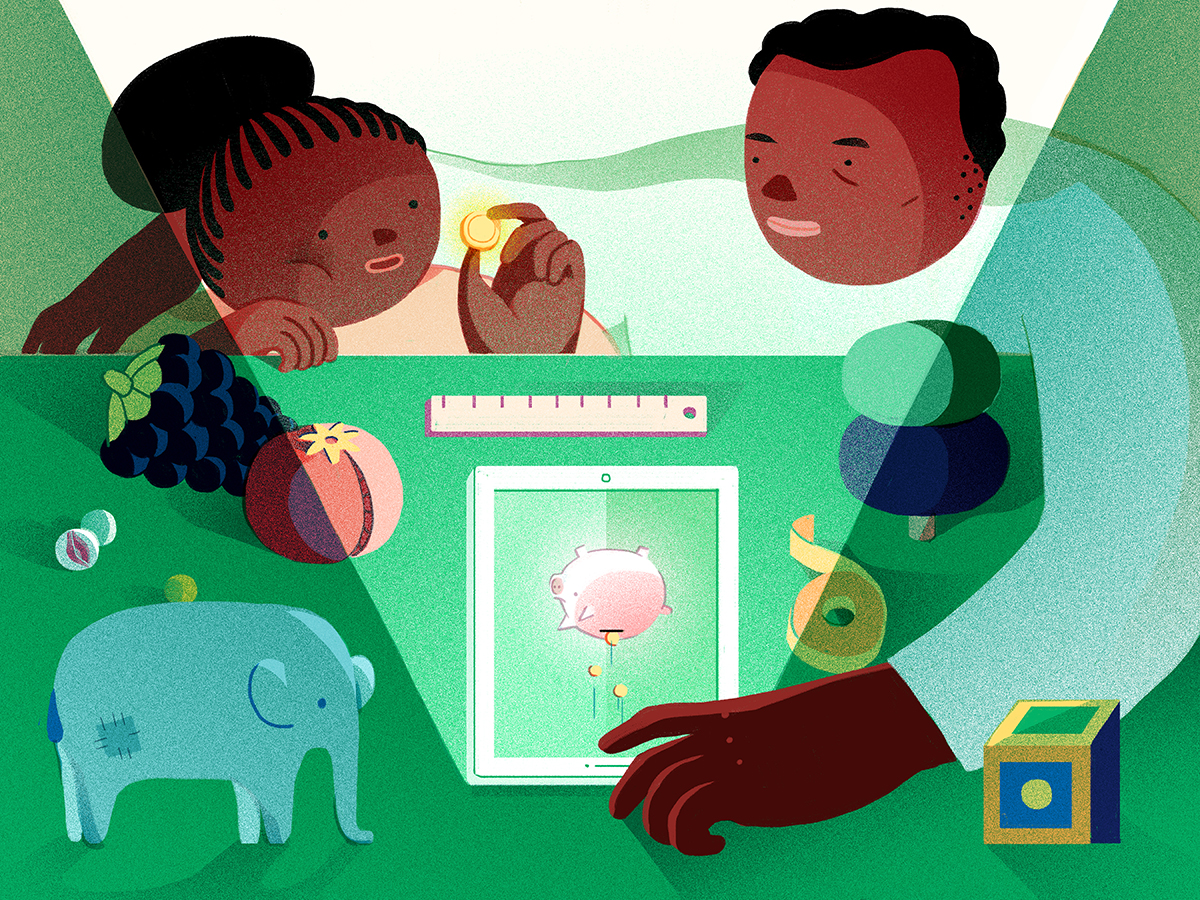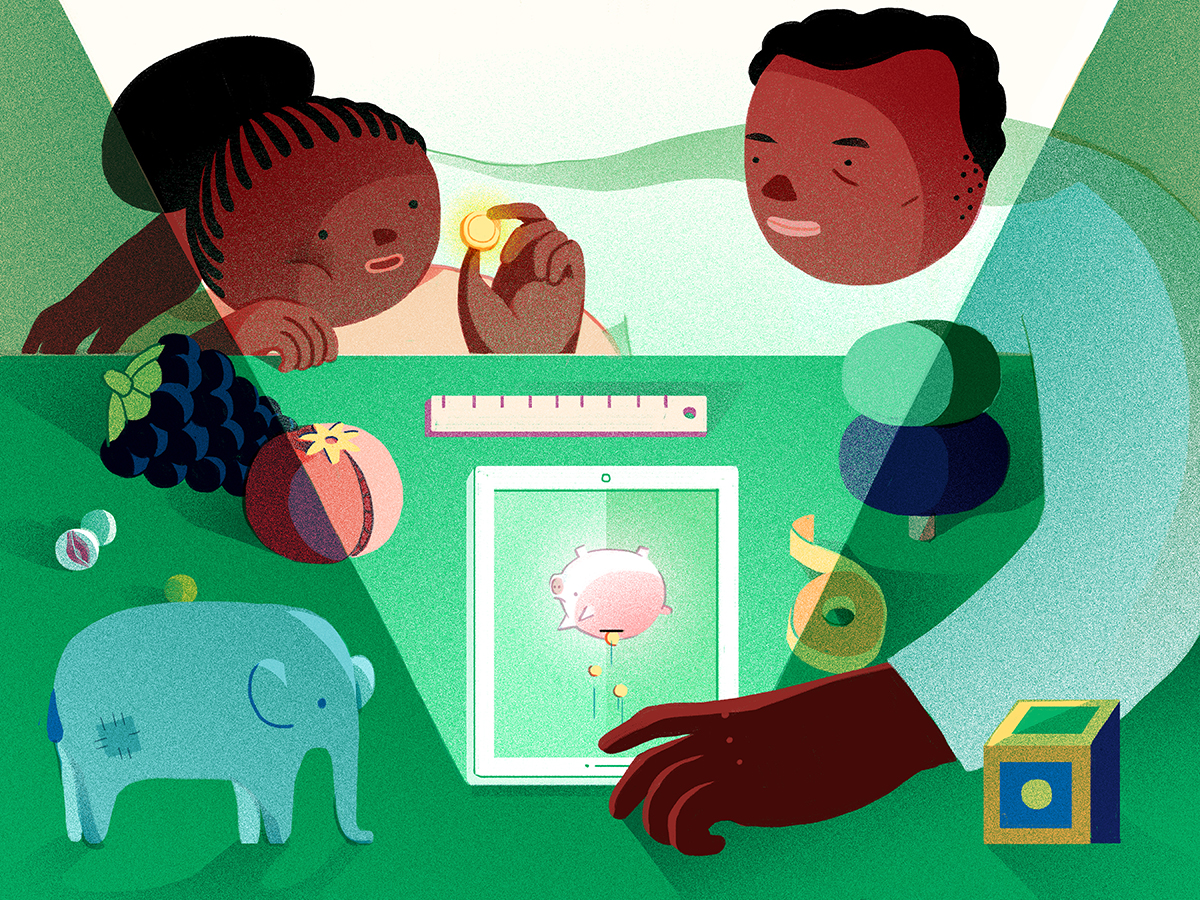
Should you give your kids a digital allowance?
 A 2018 survey by TD Bank showed that 68 per cent of parents say their children are more or just as comfortable using digital payments as handling cash (Illustration by Wenting Li)
A 2018 survey by TD Bank showed that 68 per cent of parents say their children are more or just as comfortable using digital payments as handling cash (Illustration by Wenting Li)
When 12-year-old Aiden* gets his e-allowance, it happens in the cloud. And while he’s still in elementary school and not yet a teen, he’s fully aware the transaction happens in the digital realm, not some mystical storybook cloud. It happens on the internet and that makes perfect sense to him.
“I think the norm for kids is to shop with debit cards these days,” says his mother, Kristene Howell*. “Aiden deliberately deposits all his cash and uses his card instead. His nana is old school and gives him an allowance in cash.”
In addition to those top-ups from his grandmother, a weekly automatic e-transfer goes straight into Aiden’s bank account, so the allowance is regular and predictable—which is exactly what allowance experts—such as the Financial Consumer Agency of Canada—suggest when it comes to giving out pocket money.
Aiden’s mom likes that his purchases are always visible to both her and his Dad, who lives in a different home. And when he goes on outings with friends, he can pay for his popcorn but he doesn’t have to worry about losing cash.
The Howell family is not alone. A 2018 survey by TD Bank showed that 68 per cent of parents say their children are more or just as comfortable using digital payments as handling cash. As kids get older, they become more comfortable with digital payments, with parents describing an 81 per cent comfort level for children aged 15 to 17.
Currently, there are four ways to dole out a digital allowance:
1. Bank accounts for kids
Some bank accounts for kids under 18—like the one at Royal Bank—are jointly held by the child and at least one adult. Others, for example like the one from TD Canada Trust, are solely held by the child, but an adult has signing rights and can request to receive statements.
Most accounts allow kids older than 12 to make withdrawals from ATMs and use the card for in-store purchases up to a daily limit set by a parent. Some, like Tangerine’s, have no minimum age and kids younger than 12 can use them.
2. Tracking apps
Phone apps can be used to track—and even automatically pay—electronic allowances. In Canada, RoosterMoney and Chore Check provide tracking and simple money lessons, while iAllowance connects to bank accounts and manages regular payments from an adult’s account into a child’s.
3. Prepaid cards
Prepaid cards allow teens who are at least 16 to access an e-allowance. These cards don’t require a credit check and aren’t connected to an account. But they’re convenient for parents to top up using an app such as Zenwallet, their own bank’s online bill-payment options, or, in the case of the Canada Post Reloadable Prepaid Visa card, at any Canada Post outlet across Canada.
4. Credit cards
Some families opt to make their child a secondary user of their own credit card, placing a limit on the amount of credit the child can access. In credit card statements, each user’s activity is tracked separately, bringing the whole family’s purchases into one place.
PROS AND CONS OF DIGITAL ALLOWANCE
However, an e-allowance may not be right for all families and all kids, says personal finance expert Bruce Sellery, whose 2011 book Moolala: Why smart people do dumb things with their money (and what you can do about it) became a Globe and Mail bestseller.
“The pro is that this is how the world works today,” said Sellery, father to nine-year-old Abby. “Using a card is consistent with how the world works…they’re getting used to using plastic in a low-risk way.”
But paying allowance electronically and giving your kid a debit card has downsides, too, he says. In fact, the same TD Bank Survey survey showed that 80 per cent of parents believe a cashless society can have some negative effects for kids, including making it easier to spend money, more difficulty recognizing the consequences of overspending and making it harder to learn the value of money.
“Using plastic doesn’t connect to our brains in the same way,” says Sellery. “We know that when people pay with cash they spend about 20 per cent less than when they use a credit card.”
That’s because using a card doesn’t present an exercise in managing a scarce resource, he explains. Bills and coins—physical objects that signify worth—are a better way to teach kids the ideas of scarcity and trade-offs. And that’s why he uses cash to pay his daughter her allowance, which she has earned since the age of six.
“I’m putting off using a card as long as possible,” says Sellery. “I want her to have that visceral experience of money.”
STRIKING A BALANCE
Indeed, parents should teach their kids to use cash as well as digital money, says Li Zhang, principal, corporate citizenship at CPA Canada. It’s not either-or, it’s both.
“Whether it’s digital or cash, we have to teach them the various aspects of money or they’re never going to know,” she says. “You hear stories about younger children who think the bank machine is this magical machine and they don’t necessarily understand that you have to put money in to get money out.”
While it’s true that many adults no longer carry cash, Zhang says it’s still important to make a point of modelling responsible use of paper money and talk about it openly with children, including when it’s appropriate to make digital payments and when it’s better to use currency.
LEARN HOW TO RAISE MONEY-SMART KIDS
The CPA Canada publication A Parent’s Guide to Raising Money Smart Kids helps parents with kids at different stages, from young children to emerging adults, through the five aspects of money management: earn, save, spend, share and invest.
And did you know you can invite a CPA volunteer to lead a financial literacy workshop in your community? They can help with the goals and challenges of raising money-smart kids.
*Names have been changed to protect the identity of the child.